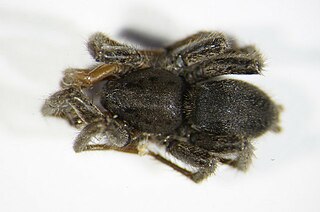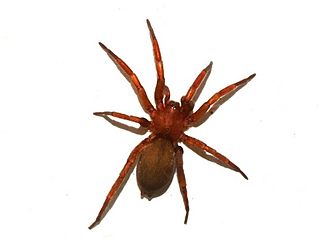
Araniella is a genus of orb-weaver spiders first described by R. V. Chamberlin & Wilton Ivie in 1942. The genus includes Araniella cucurbitina, the cucumber green spider.

Attulus is a genus of jumping spiders that was first described by Eugène Louis Simon in 1889. The name is a diminutive form of a common prefix for salticid genera, -attus.

Chalcoscirtus is a genus of jumping spiders that was first described by Philipp Bertkau in 1880. The name is derived from the Ancient Greek chalc-, meaning "copper", and scirt-, meaning "leap".

Pellenes is a genus of jumping spiders that was first described by Eugène Louis Simon in 1876. It is considered a senior synonym of Hyllothyene.

Salticus is a genus of the family Salticidae. Salticus is the type genus for the family Salticidae.

Synageles is a genus of jumping spiders that was first described by Eugène Louis Simon in 1876.

Alopecosa is a spider genus in the family Lycosidae, with about 160 species. They have a largely Eurasian distribution, although some species are found in North Africa and North America.

Drassodes is a genus of ground spiders that was first described by Niklas Westring in 1851. They are brown, gray, and red spiders that live under rocks or bark in mostly dry habitats, and are generally 3.8 to 11.6 millimetres long, but can reach up to 20 millimetres (0.79 in) in length.
Ozyptila is a genus of crab spiders that was first described by Eugène Louis Simon in 1864. It has been misspelled as "Oxyptila" in multiple accounts.

Agroeca is a genus of liocranid sac spiders that was first described by Niklas Westring in 1861.

Gnaphosa is a genus of ground spiders that was first described by Pierre André Latreille in 1804. They all have a serrated keel on the retromargin of each chelicera.

Micaria is a genus of ground spiders that was first described by Niklas Westring in 1851. They are 1.3 to 6.5 millimetres long.

Berlandina is a genus of ground spiders that was first described by R. de Dalmas in 1922.

Haplodrassus is a genus of ground spiders that was first described by R. V. Chamberlin in 1922. They range from 3 to 10 millimetres. H. signifer is the most widespread species, found across North America except for Alaska and northern Canada.

Bassaniodes is a genus of crab spiders that was first described by Reginald Innes Pocock in 1903.
Psammitis is a genus of crab spiders first described by Anton Menge in 1876.













